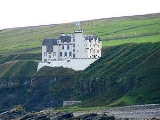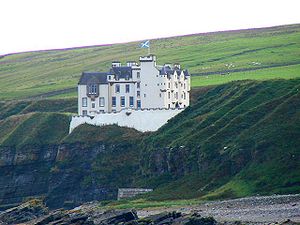
Dunbeath Castle
Encyclopedia

Caithness
Caithness is a registration county, lieutenancy area and historic local government area of Scotland. The name was used also for the earldom of Caithness and the Caithness constituency of the Parliament of the United Kingdom . Boundaries are not identical in all contexts, but the Caithness area is...
, 2 kilometres (1.2 mi) south of Dunbeath
Dunbeath
Dunbeath is a village in south-east Caithness, Scotland on the A9 road.It was the birthplace of Neil Gunn , author of The Silver Darlings, Highland River etc., many of whose novels are set in Dunbeath and its Strath...
, in northern Scotland
Scotland
Scotland is a country that is part of the United Kingdom. Occupying the northern third of the island of Great Britain, it shares a border with England to the south and is bounded by the North Sea to the east, the Atlantic Ocean to the north and west, and the North Channel and Irish Sea to the...
. Although a castle has stood here since the 15th century, the present building is of mainly 17th-century origin, with 19th century extensions.
History
A castle is first recorded on the rocky peninsula at Dunbeath in 1428, when the lands belonged to the Earl of CaithnessEarl of Caithness
Earl of Caithness is a title that has been created several times in the Peerage of Scotland, and has a very complex history. Its first grant, in the modern sense as to have been counted in strict lists of peerages, is now generally held to have taken place in favor of Maol Íosa V, Earl of...
. The first recorded laird
Laird
A Laird is a member of the gentry and is a heritable title in Scotland. In the non-peerage table of precedence, a Laird ranks below a Baron and above an Esquire.-Etymology:...
was Alexander Sutherland. It later became the property of the Clan Sinclair
Clan Sinclair
Clan Sinclair is a Highland Scottish clan of Norman origin who held lands in the north of Scotland, the Orkney Islands, and the Lothians which they received from the Kings of Scots...
through the marriage of the daughter of Alexander Sutherland to William Sinclair
William Sinclair, 1st Earl of Caithness
William Sinclair , 1st Earl of Caithness , 3rd Earl of Orkney , Baron of Roslin was a Scottish nobleman and the builder of Rosslyn Chapel, in Midlothian....
(1410–1484), the first Sinclair Earl of Caithness. The Sinclairs replaced the earlier structure with a four-storey tower house in 1620.
In March 1650, Dunbeath was attacked by the Royalist forces of James Graham, 1st Marquess of Montrose
James Graham, 1st Marquess of Montrose
James Graham, 1st Marquess of Montrose was a Scottish nobleman and soldier, who initially joined the Covenanters in the Wars of the Three Kingdoms, but subsequently supported King Charles I as the English Civil War developed...
, during the Wars of the Three Kingdoms. Sir John Sinclair rode to Edinburgh to warn of Montrose's arrival, leaving his wife to defend Dunbeath against Sir John Hurry
John Hurry
Sir John Hurry was a Scottish soldier.He was born in Aberdeenshire, and saw military service as a young man in Germany.In 1641 he returned home and became Lieutenant-Colonel in a Scottish regiment. At the end of the same year he was involved in the plot known as the "Incident"...
. She soon surrendered, and a Royalist garrison was installed. Montrose was defeated in April at the Battle of Carbisdale
Battle of Carbisdale
The Battle of Carbisdale took place close to the Village of Culrain on 27 April 1650 and was part of the Wars of the Three Kingdoms...
, and the opposition forces, under David Leslie, recaptured the castle.
The castle was extensively remodelled in the 17th century by Sir William Sinclair, and again in 1853 and 1881, when David Bryce
David Bryce
David Bryce FRSE FRIBA RSA was a Scottish architect. Born in Edinburgh, he was educated at the Royal High School and joined the office of architect William Burn in 1825, aged 22. By 1841, Bryce had risen to be Burn's partner...
was the architect. From 1894 to 1945, the castle was owned by Vice-Admiral Sir Edwyn Alexander-Sinclair. In that year, after 325 years of occupation by the Sinclair Family, the castle was sold to Bertram Currie. In 1967 it was sold again to Harry Blythe and Helen (Sinclaire) Blythe. The castle remained in their possession until 1976 when it was sold to Ray Stanton Avery. In 1997 the castle was sold to the current owner, Stuart Wyndham Murray-Threipland. The castle remains a private residence today and is not open to the public.
The castle
The oldest part of the castle lies at the south-west corner, and dates largely from the 17th century. More modern additions have been made to the north and east, in a Scots Baronial style to match the earlier building. The interiors are much altered. The defensive site was enhanced by a dry ditch on the landward side, which cuts across the narrow promontory on which the castle stands.External links
- Dunbeath Estate web site
- Dunbeath Castle, Caithness.org

